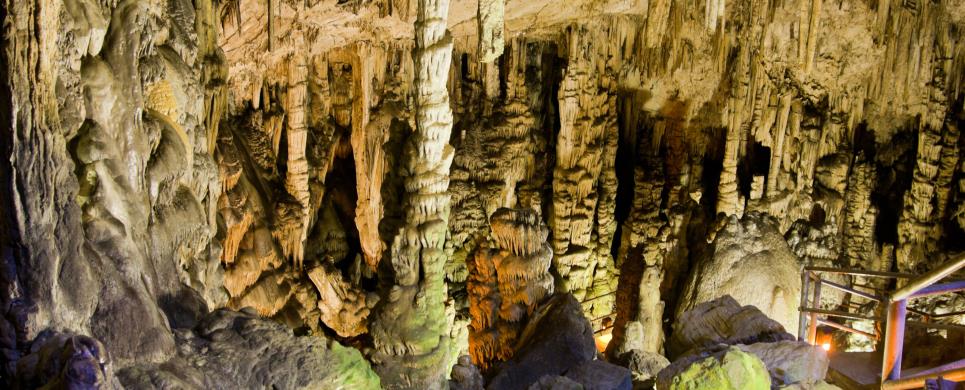Listed 3 sub titles with search on: Archaeological sites for destination: "DIKTAION ANDRON Ancient sanctuary OROPEDIO LASSITHIOU".

The cave of Psychro
is one of the most important cult places of Minoan Crete. The use of caves as cult places was one of the basic characteristics of the religious
beliefs of the ancient Cretans. Cult practice probably begins in the Early Minoan period (2800-2300 BC) - although in the antechamber are
preserved traces of an even earlier occupation - but the most important finds date from the Middle Minoan period (1800 BC) and later, as
it was used for many centuries, until the Geometric (8th century BC) and the Orientalising-Archaic period (7th-6th century BC). The finds
prove that it was visited until as late as the Roman period. Pilgrims dedicated many offerings, such as figurines of humans, gods, animals,
double axes etc. The excavators and several scholars identify the cave as the famous "Diktaian Cave", where Zeus was born and brought
up with the aid of Amaltheia and the Kouretes, and which is connected with myths as this of the seer Epimenides who "slept" here, or the
coupling of Zeus with Europa.
In the last decades of the 19th century, inhabitants of the area found ancient items inside the cave; this fact led in 1886 the
archaeologists Joseph Chatzidakis and F. Halbherr to the site, where they conducted an excavation, but not on a large scale. The cave
was also investigated by A. Evans in 1897, by J. Demargne, and by G. Hogarth in 1899, but systematic excavation has not taken place yet.
The finds uncovered during legal and illegal excavations were almost all published in 1961 by J. Boardman.
At 1,025 m. a.s.l., a steep path leads up
to a plateau in front of the narrow entrance to the cave.
On the right side is an antechamber (42 x 19 m.) with a rectangular altar, 1m. high, built of field stones; this area yielded Neolithic potsherds,
Early Minoan burials (2800-2200 BC), and offerings of the Middle Minoan period (2200-1550 BC). In the northern part of the antechamber, at
a lower level, a chamber is formed, which included an irregular enclosure with patches of roughly paved floor, forming a sort of a temenos.
The large hall (84 x 38 m.) has an inclined floor and a small chamber opening to the left end; one of its niches is called the "cradle"
of Zeus. A larger chamber (25 x 12 m.) formed on the right side is divided into two parts: one has a small pool, and the other a very impressive
stalactite, known as "the mantle of Zeus". Inside
the main chamber had been deposited many offerings, mostly bronze figurines and sheets, daggers, arrowheads, and double axes.
On the north side of Mount Dikte, in the Lassithi Plateau is the Dikteon
Andron Cave, the legendary birthplace of Zeus. The cave entrance is reached either
by walking or by a donkey ride. Good shoes with a non-slip tread are necessary.
A local man will provide a ride up and down and will give a tour of the cave with
a flashlight. Most of the guides speak only Greek. The cave entrance is reached
after a 20-minute walk up a stony path. The entrance is at 1,025 metres above
sea level and is 14.8 metres wide.
The cave of Dikteon Andron became more important than the cave of Trapeza (also
in the Lassithi Plateau) during the Prepalatial Period (2000-1700 B.C.). Its fame
continued throughout the Greek times (about 700 B.C.) when it lost its importance
to the Ideon Andron Cave in Rethimnon. Many bronze figurines, double axes, rings
and broaches have been found and are shown in the Iraklion Museum.
The cave consists of two parts: the antechamber is flat and has a length of 42
metres, a width of 19 metres and a height of 6.5 metres. An altar was here and
around it were tables for offerings which indicates that the cave was a cult centre
from the Minoan Period on. The second part is the main cave and slopes downward
leading to the lake and the four chambers at its end.
According to the legend, Zeus' father, Kronos, had sworn to devour all his children
to avoid losing his kingdom. Rhea tricked him by giving him a stone to swallow
and left Zeus in the Dikteon Cave. Here the goat nymph Amalthia nurtured him and
the Kuretes (5 Cretans) protected him. They banged their shields to drown out
the baby's crying.
This text is cited Feb 2003 from the Crete TOURnet URL below, which contains images.





Receive our daily Newsletter with all the latest updates on the Greek Travel industry.
Subscribe now!